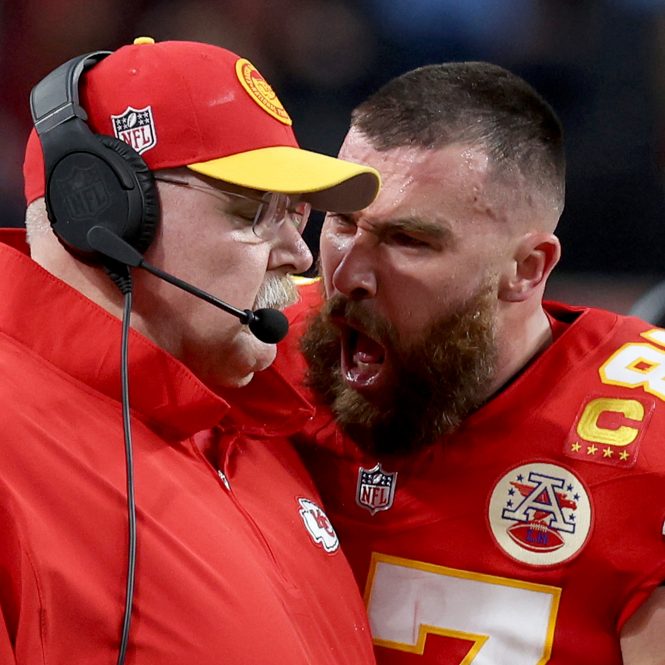Editor’s Note: Board of Trustees Distinguished Professor Sandra Chafouleas shares insights on learning from Travis Kelce’s Super Bowl sideline behavior in the following piece, which originally appeared in Psychology Today, where she publishes a blog.
Key Points
- Travis Kelce was not a positive behavior model during the Super Bowl sideline incident with Coach Andy Reid.
- Steps to behavior change include not only owning what happened but also but learning positive coping options.
- Developing flexible emotion regulation skills is important to positive coping and overall well-being.
The KC Chiefs have a lot to celebrate, with the Super Bowl win adding even more celebrity to their NFL dynasty. Congratulations are certainly in order, but there is a blemish that warrants further discussion. That blemish was a heated moment brought on by star player Travis Kelce. That moment occurred in the second quarter when Coach Reid took Kelce out of the game. Kelce was shown storming angrily toward Reid, shouting aggressively and even pushing into him. Reid was knocked off-balance, but he did not offer any on-screen reaction. A teammate pulled Kelce away, and the game continued to the Chiefs’ victorious overtime win
Social media reactions to Kelce’s behavior were almost immediately offered up, naming it with words like childish, unacceptable, and disrespectful. But those posts were quickly overtaken by accolades on the win for the team and individual players, including Kelce. When asked about the incident, Reid brushed it off with a comment about how Kelce keeps him young. Kelce also responded with a laugh and joke about keeping it between him and Reid.
Social media reactions to Kelce’s behavior were almost immediately offered up, naming it with words like childish, unacceptable, and disrespectful. — Sandra Chafouleas
NFL Legacy
There is no question that Kelce and the KC Chiefs hold superstar power, but there should be questions about the post-game handling of this sideline moment. NFL legacy has been blemished by violent behavior, such as fan concerns about increased physical violence around stadiums or player domestic violence arrest rates reported at higher than should be expected. The NFL has acknowledged the need to proactively address and prevent violent acts and has instituted programming such as public service campaigns.
An annual NFL Social Responsibility Curriculum is required of all members of NFL teams and league offices. One available topic, in fact, includes “healthy manhood and modeling appropriate behavior in family and friend relationships.” As is, footage of the Kelce-Reid incident and the dismissive comments would not fit in this curriculum. But it could be turned into a learning example by prioritizing a fairly simple analysis, just like what occurs in post-game footage review.
Healthier Coping Strategies
The incident has already happened; it’s not possible to erase that moment of high-pressure stressors that triggered undesirable behavior. But instead of brushing it aside, Kelce and Reid could have immediately owned it by stating that it wasn’t the best choice of response. They could then walk through what happened, and strategize alternative plays for Kelce in that moment. This is what’s called a behavior chain analysis, a technique used to understand why a particular behavior occurred, with the goal to identify healthier coping strategies that can “break the chain” of undesired behaviors.
The important point is that this analysis most often occurs after an event has already occurred. The person works to think back through the situation, identifying what was happening just prior to the behavior. This increased awareness helps to identify desired behavior change and figure out solutions to reduce risk of it happening again. Bringing negative emotion can be important, such as on the field, but doesn’t fit for every situation.
Stardom comes with the good and bad. It’s not easy to have every action scrutinized. But Kelce, Reid, the KC Chiefs, and the NFL should use this incident, and others like it, as opportunities to lead by example. Our society, and particularly our boys, need them to. — Sandra Chafouleas
In this sideline moment example, recognizing the intensity of the physiological response offers a start. In fact, the Kelce brothers recently addressed the inappropriateness in their recent New Heights podcast. But they stopped short of completing the full analysis; no alternative plays were offered that could support a better future outcome. Plays to settle the body through calming strategies like belly breathing or grounding it down, for example, could be useful to dial down the negative emotion that was directed toward Reid. Perhaps even a distraction like a musical cue to “shake it off” could have been helpful in that moment. Developing flexible emotion regulation skills has been related to better coping with stressors and overall well-being. It is not about shutting out emotions. It’s about embracing all emotions and also demonstrating intelligent control through use of different emotion-coping strategies in varied situations to enable desired behaviors and goals.
Stardom comes with the good and bad. It’s not easy to have every action scrutinized. But Kelce, Reid, the KC Chiefs, and the NFL should use this incident, and others like it, as opportunities to lead by example. Our society, and particularly our boys, need them to.



